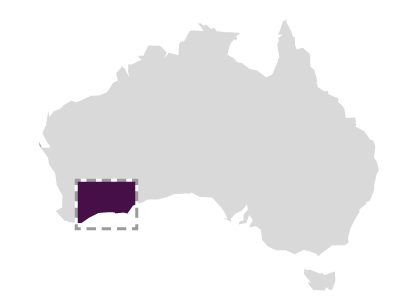Kingfisher (1905)
Princess Royal Harbour, off west of Albany Gas WOrks

Kingfisher was clinker built of iron by Hoby in Renfrew, near Glasgow in Scotland. It had one deck and a round stern and was lightly built, with clinker plating possibly of Low Moor iron. By 1857 it was owned and registered at Hobart (4/1857), the owners being John Bogle (48 shares) and Richard J. McArthur (16 shares). Bogle was also in command of the barque during their ownership. It was sold to W. Patterson, also of Hobart, in June 1858.
Described as a clipper barque, the Kingfisher was of very shallow draught. Advertised for sale at Geelong, Victoria, in January 1859, the draught was given as ‘when empty, 3 feet; when ballasted to sailing trim, 5 feet; when deeply laden, 8 feet’ (Argus, 3 January 1859: 1c). It sailed for Newcastle, NSW, on 17 January, returning on 31 January with a cargo of 227 tons of coal. It was again advertised for sale, and was stated to be ‘in first-rate order’ (Argus, 4 February 1859: 1). After another voyage to Newcastle under the command of W. Bartlett the barque was put up for auction at Lloyd’s Rooms, Collins Street, Melbourne. It was bought by the P&O Steam Navigation Company, and registered at Melbourne (No. 16/1859).
The next record is of the Kingfisher leaving Melbourne on 4 May 1859 for King George Sound with a cargo of coal. There must have been some delay, possibly due to weather, as the barque did not pass through Port Phillip Heads until six days later. The Kingfisher was heading ‘to Princess Royal Harbour…for ‘rigging down’ and use as a second coal hulk, supplementing the Larkins’ (Johnson, 1997: 66). It arrived in Albany on 1 June 1859, only five years after launching. Its short life as a trading barque was presumably due to its light construction. First used as a coal hulk, the official history of the P&O fleet states that in 1872 it was reduced to a lighter.
In April 1883 the Kingfisher parted its mooring and became stranded on the west side of the jetty, but was later salvaged and moored at the western end of Princess Royal Harbour (see entry).
THE LOSS
A severe storm in 1905 drove the hulk Kingfisher to where the wreck currently lies. By this time the lightly built barque had outlived its useful life, and was abandoned.
SITE LOCATION
The wreck of the hulk Kingfisher lies south of Melville Point at the western end of Princess Royal Harbour.
SITE DESCRIPTION
In April 1992 a wreck inspection of the Kingfisher was carried out by Dr Michael McCarthy of the Department of Maritime Archaeology, Western Australian Museum. The wreck of the Kingfisher lies upright in shallow water with the lower section of the hull, which lies on an east/west axis, buried in the sandy bottom. Almost all the hull above the high water mark has either disintegrated or collapsed. The wreck is 120 feet (36.6 m) long and 18 feet (5.6 m) wide, and the most prominent feature is the stern post, although there are some frames and the stem post also visible. The iron is covered in marine growth. There remains under the sand a considerable portion of the wooden ceiling in a good state of preservation. A winch is visible in front of the wreck.
EXCAVATION AND ARTEFACTS
During a July 1991 wreck inspection by Patrick Baker, Maritime Archaeology Department, Western Australian Museum, some samples of timber were collected.
The Kingfisher was the second coal hulk to be stationed at Albany.
Ship Built
Owner P&O Steam Navigation Company
Country Built Scotland
Port Built Renfrew
Port Registered Melbourne
When Built 1854
Ship Lost
Grouped Region South-Coast
Sinking Refloated at East end of Albany harbour
When Lost 1905
Where Lost Princess Royal Harbour, off west of Albany Gas WOrks
Latitude -35.03282
Longitude 117.869532
Position Information GPS 2005
Cargo Coal
Ship Details
Engine N
Length 36.68
Beam 5.69
TONA 164.00
Draft 2.82
Museum Reference
Official Number 31991
Unique Number 1311
Sunk Code Wrecked and sunk
File Number 2009/0140/SG _MA-10/92
Chart Number AUS 109
Protected Not protected State
Found Y
Inspected Y
Date Inspected 1991/07
Confidential NO